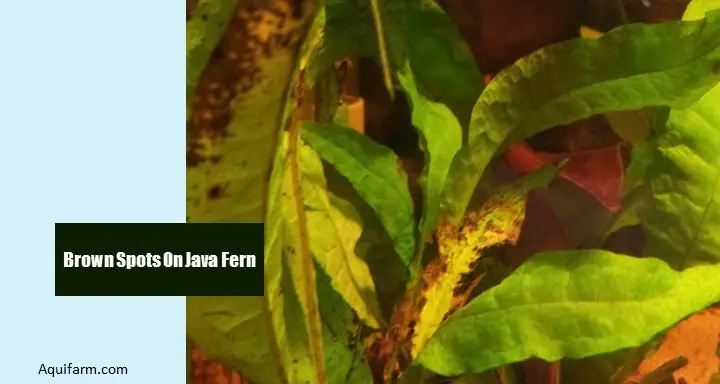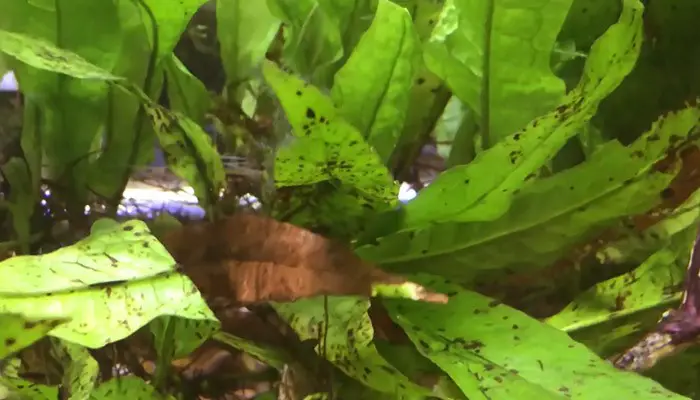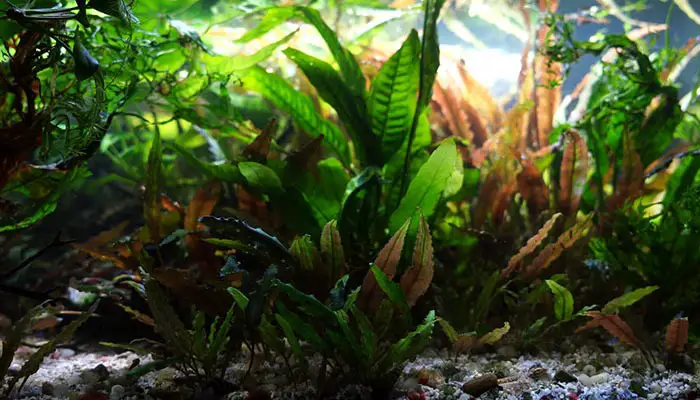
Java fern is one of the most used aquatic plants in aquariums. They are very easygoing and adapt very easily. But having brown spots on the Java fern can raise a concern about the help of the plant. Sometimes they need attention.
There are basically five main reasons behind these brown spots on Java fern. Those are excess lighting, lack of nutrients, improper anchoring, algae buildup, and asexual reproduction. Once you identify the reason behind the brown spot it is very easy to take care of them except for asexual reproduction.
Sometimes even the easy-growing plants need a bit of attention to stay healthy. Then it’s proper nutrients to grow vibrantly and give the look you one for your aquarium. Especially in the case of Java fern, it is very important to create a healthy environment for proper anchoring of the plant.
5 Reasons Behind The Brown Spots On Java Fern & Solutions

1. Too Much Lights
Java fern is a green plant that makes people think that the more light it gets the more healthy it will stay. But unfortunately, that’s not how Java fern functions. It needs low light to conduct photosynthesis. Whenever Java fern is exposed to heavy light or low light for too much time it starts to show some side effects.
One of the most common side effects that come on Java fern from excess light is brown spots on the plant. You will see small dot-like spots on the leaves and spreading to the stems. Sometimes there are lots of small dots at the beginning.
If the light is not balanced timely the brown spots on the Java fern will start to rot or turn the whole leaf into patchy brown. You may even see that spots are developing into small holes in the leaves.
Thus it is very important to take care of the extra light on Java fern before it turns to other problems. Also in the presence of excess lighting, you see that the new buds growing on Java fern die.
Solution
The solution to too much light for Java fern is to control the lighting. For this, it is very important to know how much light your Java fern actually needs.
Firstly if you are planning to put java fern in your aquarium and accommodate sunlight as a source of light make sure you put the aquarium in a place where it doesn’t get direct sunlight. The best is to put it in a low to moderate light a bit away from direct sunlight.
Make sure that the Java phone gets at least 6 hours of light and definitely not more than 12 hours in a day. It is always wise to put in 8 to 10 hours of light if possible.
In the case of artificial lighting, you can put a 3-watt light for 1 gallon of water. Do not put the light on for a long time.
If you are planning to stay away from the plan for a long time make sure you switch it off. Because in the absence of lighting, it can survive for some time but in the case of access lighting it causes brown spots and can end up ruining your Java fern plant.
2. Lack of Nutrients
In general, a Java fern is a very easy-going plant. It gets adjusted to an environment very easily with very less requirements of nutrients. But when there is too much deficiency of nutrients in the aquarium the plant starts to show symptoms like getting brown spots on the Java fern.
To stay healthy and not get any brown spots it is important that the Java fern gets proper nutrition. It needs iron, carbon dioxide, and nitrogen. Especially due to the lack of nitrogen base nutrients, you will find the presence of Brown spots in the plant. Sometimes these brown spots turn black if the nutrient is not balanced in time.
Solution
There are several nitrogenous fertilizers available on the market. They ensure that your Java fern doesn’t get brown spots. Also, try to check the level of iron and carbon dioxide in the water. Their kits are available which help to measure the level of different nutrients in the water. (Our Pick: Aqueon Plant Food)
If there is a deficiency of iron, nitrates, and carbon dioxide then use supplements to get rid of any unhealthy symptoms. Also, remember that Java fern observes nutrients from the water, not from the roots. Therefore use water-soluble fertilizer to ensure that Java has proper access to nutrients.
3. Improper Anchoring
If the java fern is not planted properly then it can have brown spots on the leaves. Java fern doesn’t have any usual roots. Rather they have rhizomes that help them to suck nutrients from the water.
Therefore if you place the Java fern in a rock or heavy substrate the growth of the Java fern gets hindered. It lacks nutrients and causes symptoms like brown spots which eventually lead to damage to the plant. Thus it is very important to anchor Java plants in a proper way.
Solution
Java fern is an aquatic plant. Therefore do not attach this plant to any stone or heavy substrate. If you want to try it at the bottom of the aquarium make sure that you’re at it with driftwood.
If you want to keep these ferns healthy it is necessary to anchor them properly. As an aquatic plant, it is completely ok for Java fern if you leave them floating in your aquarium. It grows more vibrantly without any brown spots due to anchoring if left without any support.
If you are worried about balancing them you can always tie them with a string and attach the string to something that can hold on to the Java fern. You can also take the help of the rhizomes to create a bonding. This is organic and safe.
4. Algae Build Up
Sometimes the brown spots on the Java fern are not due to any internal reason rather these are the buildup of algae. We all know that algae are necessary for some aquatic animals to feed on. Especially for the fish fry.
But sometimes this algae build-up can cause brown spots on the Java fern which ultimately leads to other problems like rotting. The place on which the Java fern gets algae buildup, it gets deprived of other requirements.
Solution
The solution to algae buildup to get rid of the brown spot is reducing the number of algae in the aquarium. Also if you already have got those brown spots you can clean them.
The planning process of algae is not very difficult, especially for aquatic plants like Java fern which can easily be taken out of the aquarium as they do not create a strong connection with their anchored body.
For this, you will need to take out the java fern from the aquarium. Pull them out with your hands or clamps. But be gentle with it. Try not to harm the rhizomes as much as possible. This ensures that when you again put the Java fern into the aquarium it stays healthy.
Soak the Java fern in 10% bleach. Do not keep it in the bleach for more than 4 minutes. If the plant is younger, lower the time limit. Once soaking is done with the help of cotton cloth, delicately remove the algae from the leaves.
As the leaves of Java fern are on the elongated side it is easier to handle the algae build-up. During this process, you need to be gentle with the young plants and the young leaves on the older plants. Try to be delicate as much as possible.
5. Asexual Reproduction
In the asexual reproduction of Java fern, it takes the help of apomixis. This apomixis helps Java fern to clone itself. That means the raisins will come out of the leaves and it will create a new plant. When this happens you will notice that there are brown spots on your Java Fern leaves.
These brown spots for asexual reproduction can appear overnight. Therefore aquarium owners often get tensed about these spots. But this is a completely natural process and helps you to get more healthy Java fern that you can sell or reuse in your other aquarium.
Solution
Asexual reproduction by Java fern is a completely natural process. There are lots of people who do this kind of reproduction. Especially the plants that don’t get flowers in them. It is not a disease that needs to be cured.
Just make sure these brown spots are apomixis, and leave them as they are. Within a short amount of time, you will see the healthy growth of a new plant through rhizomes.
Taking Care of Java Fern

To ensure that your plant is healthy, here are some tips and tricks that will help you to maintain a healthy environment in your aquarium along with the java fern.
- Check the pH balance of the water from time to time. Meeting a range between 6 to 8.
- Always have a water purifier installed in the aquarium. The filtered water has a lesser chance of building algae to form brown spots on the Java fern.
- Regularly check the level of potassium, nitrate, carbon dioxide, and iron in the aquarium water. If it’s lower than necessary, use proper fertilizer to intensify the level.
- Try to plant similar types of feeder plants together. Therefore you do not have to use different formats of fertilizers whether you can choose water-soluble fertilizers or root tabs.
FAQs
Why Are My Fern’s Leaves Turning Brown?
Assuming that you’re seeing earthy colored leaves everywhere, your java fern may not be getting sufficiently moist. They like their dirt to be gently wet, however not wet, so check them routinely and water them assuming the dirt at any point feels dry. Utilize the finger plunge test: on the off chance that you put a finger in and it comes out dry, they could seriously use a beverage.
Should I Cut Off Brown Java Fern Leaves?
It ought to possibly be cut when it gets very lengthy. Cut it into two pieces, every one of which should have a couple of leaves developing from it. To permit the new plant to develop, ensure that you cover the roots in the substrate in the tank and that the rhizome and leaves are uncovered.
Do Java Ferns Need To Be Completely Submerged?
As java fern Microsporum is an aquatic plant that can develop completely in an established aquarium, most would agree that it loves stickiness! This turns out as expected whether it’s completely or to some degree lower, and its underground root growth and rhizome ought to be in touch with water continually for best development.
Can Java Fern Be Planted In The Sand?
To establish Java fern into the sand substrate, simply make an opening into the sand with your finger and afterward put its rhizomes into the substrate and cover it with sand. Java plants can fill your tank with practically no manure. But it is not wise to put Java fern in the substrate.
How Do You Make A Java Fern Bushy?
On the off chance that you need a really lengthy, ragged Java Fern plant rapidly, just let it develop. As new puppies are made on the leaves of this gigantic oceanic plant’s fronds and stem, rather than eliminating these infants to make different plants through and through – let them be.
Final Words
Whenever a plant is sick it shows you symptoms and tells you that it needs attention. Brown spots on Java Fern are something like that. It is the plant’s way of telling you that I need attention and care.
All the reasons mentioned for the brown spots can be taken care of. Except for asexual reproduction, if the brown spots are left untreated they will create holes in the leaves. And gradually the holes will spread all over the plant. Sometimes they will not even create holes and turn to plant ugly brown colors.
It is very important to remember that when you are planting any plants in the aquarium try to balance their nature. Like the root feeder plants with the root feeder. This way there is well-balanced nutrition among all the habitats of the aquarium.
- Top 15 Freshwater Aquarium Plant Ideas for a Lush, Green Tank - November 9, 2024
- Top 13 Freshwater Aquarium Layout Ideas for a Beautifully Organized Tank - November 9, 2024
- 14 Stunning Rustic Freshwater Aquarium Ideas for a Tranquil Environment - November 9, 2024
